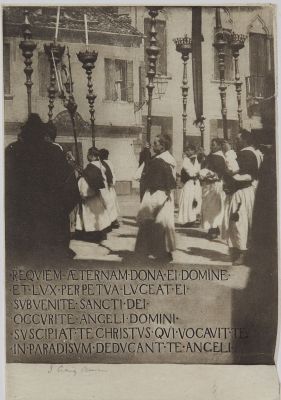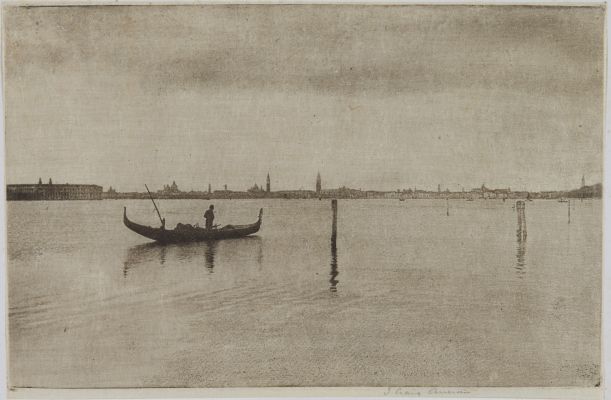
Title
A Black CanalArtist
Annan, James Craig (Scottish, 1864-1946)Key FigurePublication
Venice and LombardyDate
1896Process
Photogravure (tissue)Atelier
James Craig AnnanImage Size
9.5 x 15 cm
Until we learn more about the subject of art photogravure, James Craig Annan remains its greatest commercial practitioner, particularly in the direction of miniaturist clarity as opposed to the soft smoky atmosphere of the pictorialists which begins with the restrained in-and-out-of-focus attitude of Peter Henry Emerson, the medium’s greatest private practitioner and the father of 20th century photography. Sam Wagstaff
James Craig Annan brought the art of photogravure to its highest levels of achievement. This print combines the tonal subtleties of this process with the drama of a shrewdly observed and framed moment, caught spontaneously. Here we have an instance of the choice of subject which would not be seen at all by the ordinary (i. e. unobservant) camera man. And it will be noticed that the part which the ordinary individual would trim away has been retained, while the part most likely to be retained has been omitted. These facts in some degree contribute to its interest and freshness, or what was freshness in ’93; for alas! [1]
Since the early nineties James Craig Annan had been one of the chief forces in the development of pictorial photography. This portfolio of prints is his masterpiece. Limited to an edition of 75, the eleven plates include some of Annan’s most sophisticated and celebrated early work. The small photogravures masterfully etched and printed by Annan himself on Japan tissue and individually signed, explore for the first time the instantaneous moments accessible only to the camera combined with the control, art and craft of traditional etching. The tension between photography emulating painting and a truthful photography able to represent a new art form is clearly visible in Venice and Lombardy and reveals Annan’s ability to articulate the most advanced issues of his time. The portfolio, according to Ken Jacobson, contains signed, tiny, gem-like photogravures that might be seen as the precursor for the style of Camera Work – Stieglitz’s widely praised journal, vehicle of modern photography and photogravure tour-de-force. Stieglitz greatly admired Annan and was certainly influenced by this work.
Reproduced / Exhibited
An Exhibition on Photographic Reproduction Processes from The Collection of Samuel J. Wagstaff, Jr. at the Grolier Club. 1983
John Taylor, Pictorial Photography in Britain 1900-1920, London, 1978, pl. 19, p. 52;
Naef, Weston J. The Collection of Alfred Stieglitz: Fifty Pioneers of Modern Photography. New York: Viking Press, 1978. no. 23.
Buchanan, William The Art of the Photographer J. Craig Annan 1864-1946, National Galleries of Scotland, 1992, pl. 28.
Rosenblum, Naomi. A World History of Photography. New York: Abbeville Press, 2008. no. 369.
Caffin, Charles H, and Thomas F. Barrow. Photography As a Fine Art: The Achievements and Possibilities of Photographic Art in America. New-York: Morgan, 1901 p.11
References
[1] Lambert, "The Pictorial Work of J. Craig Annan". The Practical Photographer, Library Series, no. 13, (1904), p. 1-5.
Buchanan, William. J. Craig Annan: Selected Texts and Bibliography. Oxford: Clio Press, 1994. fig. 9. P. 8 and p 83
Bologna, Gabriella, ‘The Aesthetics of British Photography. A Case Study: James Craig Annan’s Portfolio Venice and Lombardy’ in Anon. 2013. Aesthetic Lives : ‘New Experiences New Subjects of Poetry New Forms of Art’. High Wycombe Bucks England: Rivendale Press











